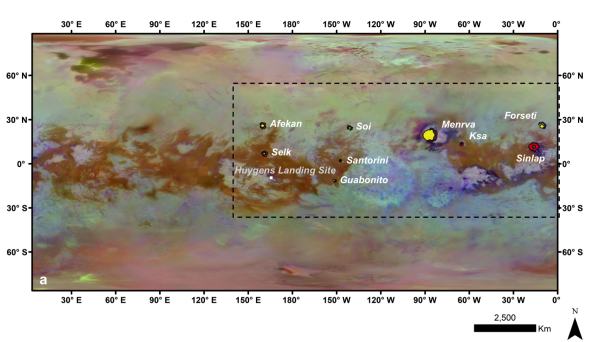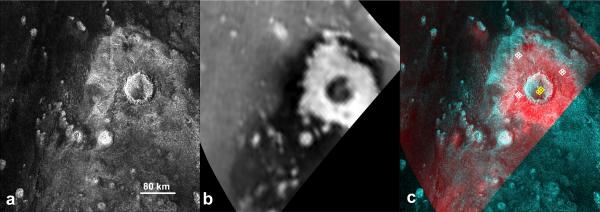Craters reveal Titan is still a dynamic world
29 October 2020
Using data from the international Cassini-Huygens mission to Saturn and Titan, scientists have found that there are two distinct types of craters on Saturn's largest moon Titan that are still being shaped by erosion. |
| Dune and plain impact craters on Titan. Credit: Solomonidou et al. (2020); background map: Le Mouélic et al. (2019) |
Titan has a dense atmosphere, a subsurface ocean, and a surface adorned with mountains, lakes, dunes, and many other Earth-like features. It is also scarred with impact craters, although relatively few compared to other moons of Saturn. It is thought that erosion has obscured most of the craters on Titan, similar to what has happened on Earth. Not only does studying Titan's craters reveal the geomorphological processes on the moon, but the craters give an insight into the subsurface composition as they carve out a small pocket in the surface.
Anezina Solomonidou and colleagues have recently published a paper in Astronomy & Astrophysics which performs a detailed analysis of nine prominent craters on Titan. Analysing craters is a key way to study Titan's interior and the atmospheric influence on the surface.
"When we study the astrobiological potential of an ocean-bearing world like Titan, it is vital to look for pathways for organic material, for example mixtures that contain important elements, like carbon," says Anezina. "These can be recognizable at the surface and in the atmosphere after being transported from the subsurface ocean, which is the most likely habitable environment, and vice versa. Impact craters are one of the few geologic features that expose material from the interior, providing a rare opportunity to understand the subsurface composition of Titan."
Six of the craters in the study are located in the equatorial dune fields and three in the midlatitude plains. They used data from two instruments on the Cassini orbiter; the Visual and Infrared Mapping Spectrometer (VIMS) and RADAR, along with information provided by the Huygens Titan lander.
RADAR obtained microwave emissivity data – which is a measure of how effective a surface is at emitting energy – and could probe the surface to depths of tens of centimetres revealing details on the subsurface composition. Areas with lower emissivity on Titan are thought to indicate water ice, while higher emissivity indicates an organic-rich layer.
The VIMS data can be used to look at the thin 'veil' that covers the surface. Using VIMS to study the surface of Titan requires an understanding of the methane absorption and haze in the atmosphere, which was provided by the Huygens data and the use of a radiative transfer code. The team then used a new mixing model to study the chemical composition of the crater floors and ejecta blankets (i.e. material thrown out of the crater area during the impact).
 |
| RADAR and VIMS view of Sinlap crater on Titan. Credit: Solomonidou et al. (2020) |
The results showed that the dune craters and the plain craters have two different types of composition. The plain craters have a mix of organics and are enriched with water ice, whereas the dune craters have mainly organic material and no water ice. Both types of craters have been altered compositionally showing two different evolution routes.
The VIMS data shows a difference in abundances between the crater floors and ejecta blankets for the dune craters, which is in contrast to the RADAR data. This suggests that there is a difference in the surface layer between the floor and ejecta that doesn't affect the subsurface composition. It is possible that this is due to the dune craters becoming infilled with a fine layer of sand sediment.
The composition of craters and ejecta is generally the same for the plain craters, which the authors say suggests that the plain craters are being "cleaned" of sediment. This could be caused by fluvial erosion, and agrees with previous assumptions that more rain falls in the higher latitudes of Titan.
There are two craters which are exceptions to the rule; Menrva and Sinlap. Menrva, is the largest crater on Titan at around 425 kilometres across, which means it intersects both the dunes and the plains. Sinlap is thought to be the youngest crater and while it is located in the dune region, it has signs of water ice and doesn't display the same characteristics of a dune crater and couldn't be classified into either of the two groups. It is possible that the dune craters originally had exposed water ice which was then covered with organic material, and Sinlap's younger age means that this process is still occurring. Erosion is thought to occur quite quickly with even the younger craters covered by a thin layer of organic material.
"Titan seems to have a compositional latitudinal dependence that is also reflected in the impact craters as well," says Anezina. "This latitudinal dependence seems to unveil many of Titan's secrets, showing us that the surface is actively connected with atmospheric processes and possibly with internal ones."
Further investigation of Titan's craters will be possible in the future when NASA's Dragonfly lander mission visits Selk, one of the dune craters. The mission is due to launch in 2027 and arrive at Titan in 2034 to study several sites on the moon.
More information
"The chemical composition of impact craters on Titan - I. Implications for exogenic processing" by A. Solomonidou et al. is published in Astronomy & Astrophysics.
For more information, please contact:
Anezina Solomonidou
European Space Astronomy Centre (ESAC)
Villanueva de la Cañada, Spain
E-mail: anezina.solomonidou![]() esa.int
esa.int


